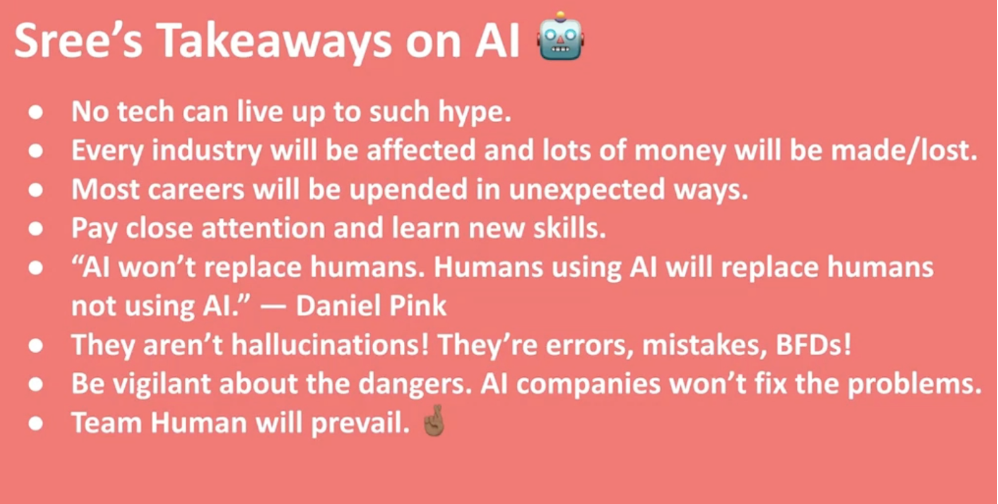By Xueer Hao and Dr. Brett Ashley Crawford
Sustainability and AI were at the forefront this year at the American Alliance of Museums (AAM) Future of Museums Summit. Keynote speaker Rob Hopkins, a self-proclaimed “time traveler,” set a hopeful and inspiring tone for the conference by showing a glimpse of the future from “his last visit to 2030.”
Cities becomes more biker- and pedestrian-friendly
Concrete and tarmac are removed to liberate the soil
Hyper-local impact and high energy efficiency
Energy comes from renewables and the community owns the system
A whole new infrastructure with a food belt around the city with shops in the center
Rainforest in schools
Top jobs are more land-, nature-, and farm-based, such as Seaweed Farmer, Rooftop farmer, Organic Stylist, or Solar Chef
Quoting Willian Gibson, “the future is already here – it’s just not evenly distributed.” Hopkins then revealed that some countries, such as Belgium, are already living in this future, and museums can help us get there. It is as if museums have a collective mission: to inspire hope and cultivate the longing for the future. Being hopeful for the future is made possible by actions we can take in the present.
AI Adolescence
AI is a young tool that still needs discipline and guidance to behave. While AI’s impact is evident and widespread in almost all sectors of society, there are still exaggerations about the technology. AI is now in the second wave of evolution, having progressed from classification to generative, but it is far from autonomous operating. Instead, what best describes AI’s function is amplifying and augmenting humanity.
Humans will not yet be replaced by AI, but humans using AI will replace those who don’t. This raises the question of what kind of human will prevail. If the cultural sector and museums want to continue inspiring and forging longing, adapting to the new technology is vital to stay relevant. Our ability to maintain relationships with people outside the museum depends on technology.
Source: “Can I Get a Little Help: AI & Small Museums”
Ways Museums are Using AI
Using AI to improve accessibility: for example, accelerating the production of visual descriptions, audio tours, or interactive labels using generative AI for blind or low-vision viewers
Understanding visitor feedback and engagement with art and museums
Extracting Data
Partnering for creative brainstorming, such as generating title ideas for articles, donor letters, volunteer appreciation letters
Building chatbot with Open AI for visitors to ask questions about the exhibition piece
Generating dialogue with museum resources, such as extending the story beyond the museum area of the collection
Supporting neurodivergent staff members with additional communication resources so they can focus more on creative strength
Identifying potential pitfalls: for example, letting AI roleplay a visitor experience to give staff feedback on materials and things one might miss
What to Look for When Using AI
With a new potential career being “prompt engineering,” it is abundantly clear that writing better prompts is going to be a crucial skill. Knowing the steps of AI’s reasoning process, like solving math questions, is a good way of correcting AI hallucinations.
o Why do you think that?
o What evidence do you have?
o Any chances you have made mistakes?
If you are considering partnering with a vendor, there are several things to consider, including:
Building your infrastructure’s capacity for more computing power
Discussing how using AI aligns with mission and long-term goals
Being mindful of the varying levels of technology knowledge in staff
While generative AI interfaces seem easy, getting the right answer takes thoughtful work. Furthermore, engaging with any new technology can create stress and even harm. To prevent some of those issues, be sure to issue clear statements to staff about how AI is being used to assist them, not to replace them. Noting that you will be providing training for people with different technology comfort levels is important with any new tech, especially AI. If there is time and space, having “learning labs” could be another potential intervention. Also, clarifying how to use - or how not to use - AI helps people know boundaries. In setting those boundaries, be sure to clarify that these are guidelines, not hard-set policies, as the rapid nature of technology may require quick adjustment.
Source: Sree Sreenivasan, “AI & Museums: Beyond the Hype and the Backlash”
MUSEUMS AND HEALTH
Technology and other changes in our world have had impacts on our health. It is notable that as technology advances in our lives, from social media and email to online consumerism, our stress and sense of loneliness has also grown — so much so that the World Health Organization has pronounced loneliness to be a global health concern. Social connection decreases loneliness, and connection is something museums do incredibly well. In fact, arts-based programs are increasing across the country and globe to support community and individual health.
While the Art Pharmacy has received coverage in recent years, local solutions can also work. Molly Phillips of the Bechtler Museum of Modern Art presented how Charlotte, North Carolina, has created a collaborative network of arts providers and health care professionals. For their work, they recognize that a) you must partner with a healthcare provider and b) that educating how to diagnose loneliness using existing scales is essential.



